MCSD Developing ASP.NET MVC 4 Web Applications v1.0
Question 1
Background -
You are developing a video transcoding service. This service is used by customers to upload video files, convert video to other formats, and view the converted files. This service is used by customers all over the world.
Business Requirements -
The user-facing portion of the application is an ASP.NET MVC application. It provides an interface for administrators to upload video and schedule transcoding. It also enables administrators and users to download the transcoded videos.
When videos are uploaded, they are populated with metadata used to identify the video. The video metadata is gathered by only one system when the video upload is complete.
Customers require support for Microsoft Internet Explorer 7 and later.
The application contains a header that is visible on every page.
If the logged-on user is an administrator, then the header will contain links to administrative functions. This information is read from a cookie that is set on the server. The administrative links must not be present if an error condition is present.
Technical Requirements -
User Experience:
The front-end web application enables a user to view a list of videos.
The main view of the application is the web page that displays the list of videos.
HTML elements other than the list of videos are changed with every request requiring the page to reload.
Compatibility:
Some customers use browsers that do not support the HTTP DELETE verb.
These browsers send a POST request with an HTTP header of X-Delete when the intended action is to delete.
Transcoding:
The video transcoding occurs on a set of Windows Azure worker roles.
The transcoding is performed by a third-party command line tool named transcode.exe. When the tool is installed, an Environment variable named transcode contains the path to the utility.
A variable named license contains the license key. The license for the transcoding utility requires that it be unregistered when it is not in use.
The transcoding utility requires a significant amount of resources. A maximum of 10 instances of the utility can be running at any one time. If an instance of the role cannot process an additional video, it must not prevent any other roles from processing that video.
The utility logs errors to a Logs directory under the utilities path.
A local Azure directory resource named perf is used to capture performance data.
Development:
Developers must use Microsoft Remote Desktop Protocol (RDP) to view errors generated by the transcode.exe utility.
An x509 certificate has been created and distributed to the developers for this purpose.
Developers must be able to use only RDP and not any other administrative functions.
Application Structure -
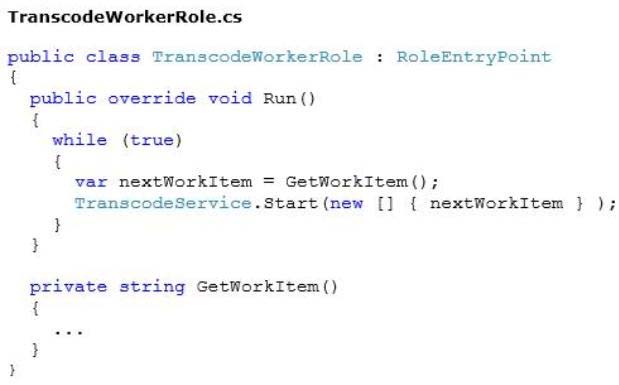
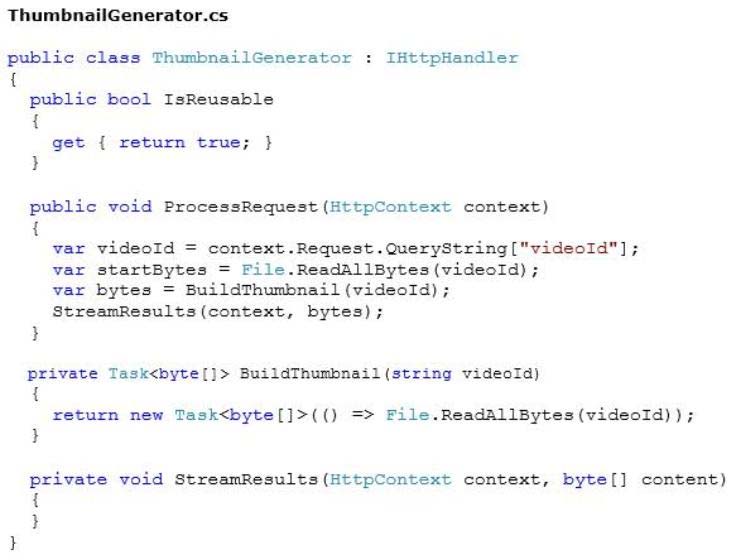
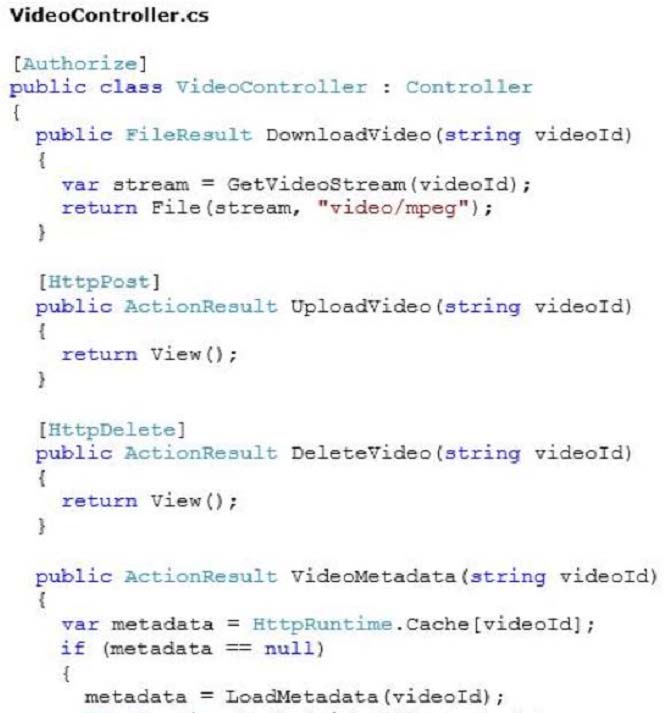
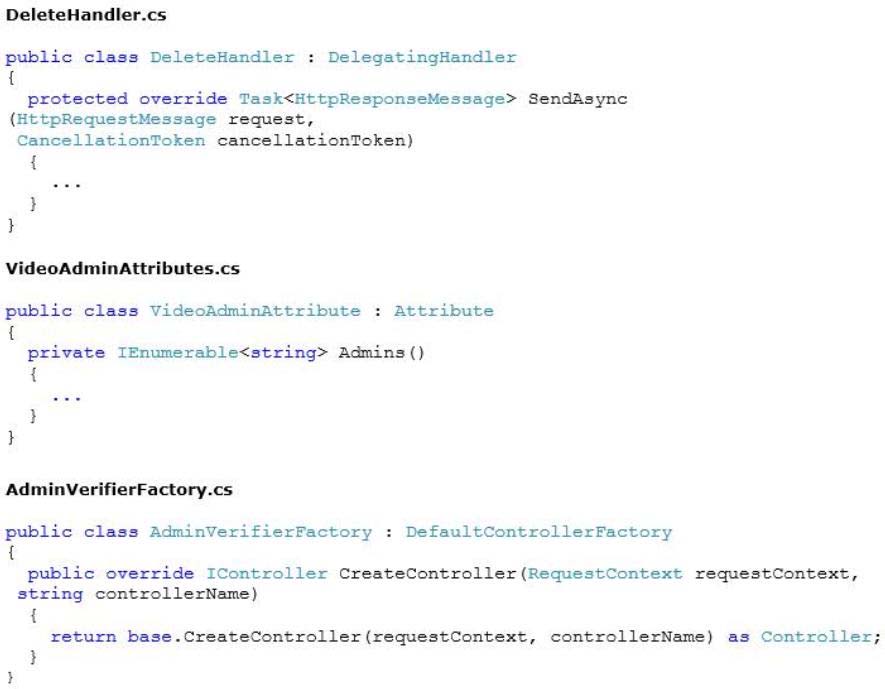
You need to ensure that all the MVC controllers are secure.
Which code segment should you use as the body for the CreateController method in AdminVerifierFactory.cs?
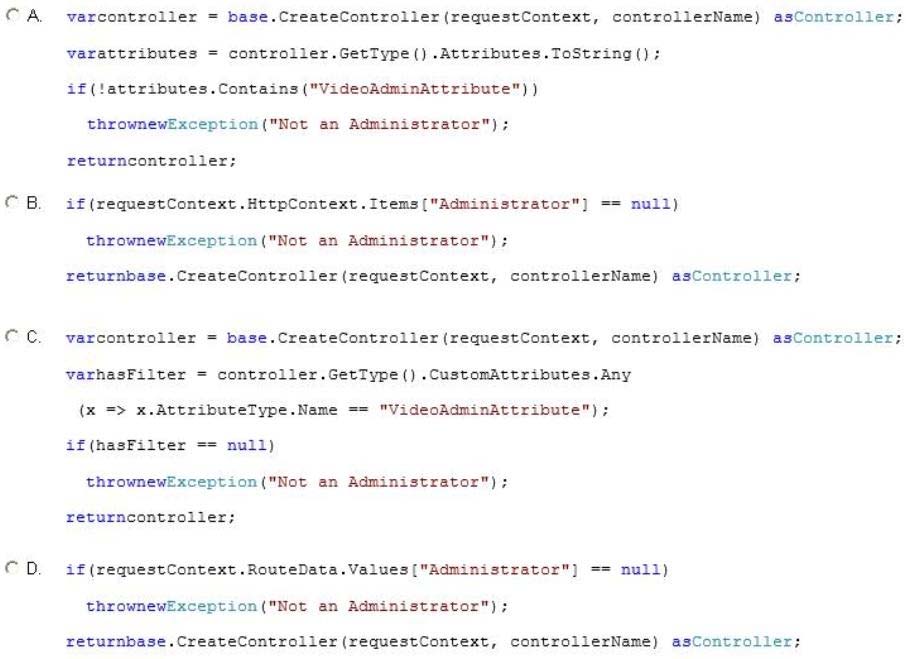
- A. Option A
- B. Option B
- C. Option C
- D. Option D
Answer : C
Explanation:
The MemberInfo.CustomAttributes property gets a collection that contains this member's custom attributes.
The Any() statement will either return null or a collection of matched custom attributes. If it matches one or more, the controller is secure, otherwise an exception is thrown.
From scenario: The application contains a header that is visible on every page.
If the logged-on user is an administrator, then the header will contain links to administrative functions. This information is read from a cookie that is set on the server. The administrative links must not be present if an error condition is present.
Incorrect:
Not A: controller.GetType().Attributes will not return custom attributes.
References:
https://msdn.microsoft.com/en-us/library/system.reflection.memberinfo.customattributes(v=vs.110).aspx
Question 2
Background -
You are developing a video transcoding service. This service is used by customers to upload video files, convert video to other formats, and view the converted files. This service is used by customers all over the world.
Business Requirements -
The user-facing portion of the application is an ASP.NET MVC application. It provides an interface for administrators to upload video and schedule transcoding. It also enables administrators and users to download the transcoded videos.
When videos are uploaded, they are populated with metadata used to identify the video. The video metadata is gathered by only one system when the video upload is complete.
Customers require support for Microsoft Internet Explorer 7 and later.
The application contains a header that is visible on every page.
If the logged-on user is an administrator, then the header will contain links to administrative functions. This information is read from a cookie that is set on the server. The administrative links must not be present if an error condition is present.
Technical Requirements -
User Experience:
The front-end web application enables a user to view a list of videos.
The main view of the application is the web page that displays the list of videos.
HTML elements other than the list of videos are changed with every request requiring the page to reload.
Compatibility:
Some customers use browsers that do not support the HTTP DELETE verb.
These browsers send a POST request with an HTTP header of X-Delete when the intended action is to delete.
Transcoding:
The video transcoding occurs on a set of Windows Azure worker roles.
The transcoding is performed by a third-party command line tool named transcode.exe. When the tool is installed, an Environment variable named transcode contains the path to the utility.
A variable named license contains the license key. The license for the transcoding utility requires that it be unregistered when it is not in use.
The transcoding utility requires a significant amount of resources. A maximum of 10 instances of the utility can be running at any one time. If an instance of the role cannot process an additional video, it must not prevent any other roles from processing that video.
The utility logs errors to a Logs directory under the utilities path.
A local Azure directory resource named perf is used to capture performance data.
Development:
Developers must use Microsoft Remote Desktop Protocol (RDP) to view errors generated by the transcode.exe utility.
An x509 certificate has been created and distributed to the developers for this purpose.
Developers must be able to use only RDP and not any other administrative functions.
Application Structure -




You are creating a new authentication system that uses an HTTP header value.
The existing authentication system must continue to operate normally.
You need to implement the custom authentication.
What should you do? (Each correct answer presents a complete solution. Choose all that apply.)
- A. Create a class derived from ActionResult and check for a valid HTTP header value in the ExecuteResult method. Change all actions to return this new class.
- B. Create an HttpHandler to check fora valid HTTP header value in the ProcessRequest method.
- C. Create an HttpModule and check for a valid HTTP header value in the AuthenticateRequest event.
- D. Create a class derived from AuthorizeAttribute and check for a valid HTTP header value in the AuthorizeCore method. Change usages of the existing AuthorizeAttribute to use the new class.
Answer : CD
Explanation:
Question 3
Background -
You are developing a video transcoding service. This service is used by customers to upload video files, convert video to other formats, and view the converted files. This service is used by customers all over the world.
Business Requirements -
The user-facing portion of the application is an ASP.NET MVC application. It provides an interface for administrators to upload video and schedule transcoding. It also enables administrators and users to download the transcoded videos.
When videos are uploaded, they are populated with metadata used to identify the video. The video metadata is gathered by only one system when the video upload is complete.
Customers require support for Microsoft Internet Explorer 7 and later.
The application contains a header that is visible on every page.
If the logged-on user is an administrator, then the header will contain links to administrative functions. This information is read from a cookie that is set on the server. The administrative links must not be present if an error condition is present.
Technical Requirements -
User Experience:
The front-end web application enables a user to view a list of videos.
The main view of the application is the web page that displays the list of videos.
HTML elements other than the list of videos are changed with every request requiring the page to reload.
Compatibility:
Some customers use browsers that do not support the HTTP DELETE verb.
These browsers send a POST request with an HTTP header of X-Delete when the intended action is to delete.
Transcoding:
The video transcoding occurs on a set of Windows Azure worker roles.
The transcoding is performed by a third-party command line tool named transcode.exe. When the tool is installed, an Environment variable named transcode contains the path to the utility.
A variable named license contains the license key. The license for the transcoding utility requires that it be unregistered when it is not in use.
The transcoding utility requires a significant amount of resources. A maximum of 10 instances of the utility can be running at any one time. If an instance of the role cannot process an additional video, it must not prevent any other roles from processing that video.
The utility logs errors to a Logs directory under the utilities path.
A local Azure directory resource named perf is used to capture performance data.
Development:
Developers must use Microsoft Remote Desktop Protocol (RDP) to view errors generated by the transcode.exe utility.
An x509 certificate has been created and distributed to the developers for this purpose.
Developers must be able to use only RDP and not any other administrative functions.
Application Structure -




HOTSPOT -
The designer for the website gave you the following image as the design for the page.

The normal color for the tab is *2da4c2, and the color when the mouse is over the tab is #ffd800.
The HTML that implements the navigation tab is as follows.

You need to implement the design.
What should you do? (To answer, select the appropriate options in the answer area.)
Hot Area:
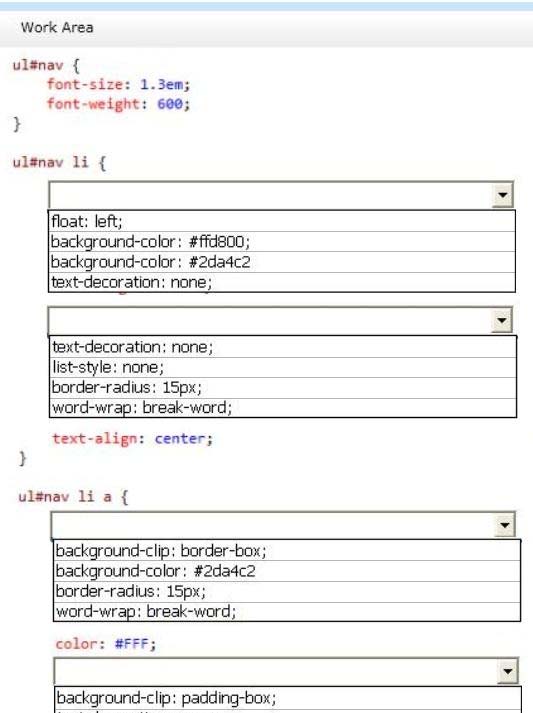
Answer : 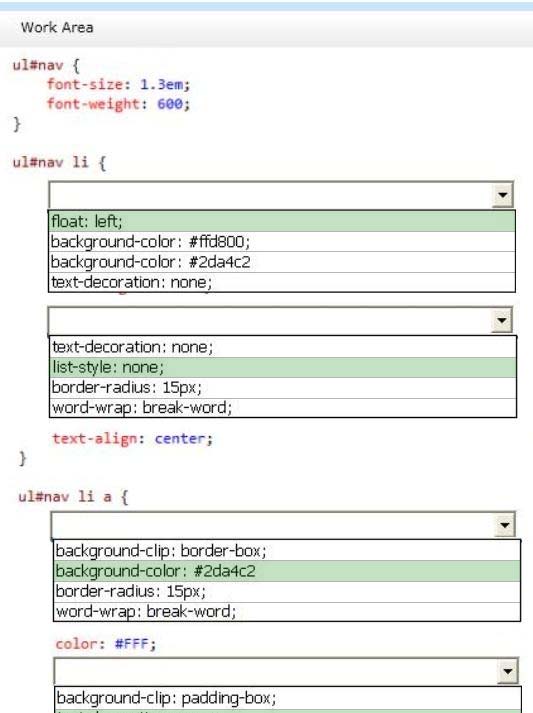
Question 4
Background -
You are developing a video transcoding service. This service is used by customers to upload video files, convert video to other formats, and view the converted files. This service is used by customers all over the world.
Business Requirements -
The user-facing portion of the application is an ASP.NET MVC application. It provides an interface for administrators to upload video and schedule transcoding. It also enables administrators and users to download the transcoded videos.
When videos are uploaded, they are populated with metadata used to identify the video. The video metadata is gathered by only one system when the video upload is complete.
Customers require support for Microsoft Internet Explorer 7 and later.
The application contains a header that is visible on every page.
If the logged-on user is an administrator, then the header will contain links to administrative functions. This information is read from a cookie that is set on the server. The administrative links must not be present if an error condition is present.
Technical Requirements -
User Experience:
The front-end web application enables a user to view a list of videos.
The main view of the application is the web page that displays the list of videos.
HTML elements other than the list of videos are changed with every request requiring the page to reload.
Compatibility:
Some customers use browsers that do not support the HTTP DELETE verb.
These browsers send a POST request with an HTTP header of X-Delete when the intended action is to delete.
Transcoding:
The video transcoding occurs on a set of Windows Azure worker roles.
The transcoding is performed by a third-party command line tool named transcode.exe. When the tool is installed, an Environment variable named transcode contains the path to the utility.
A variable named license contains the license key. The license for the transcoding utility requires that it be unregistered when it is not in use.
The transcoding utility requires a significant amount of resources. A maximum of 10 instances of the utility can be running at any one time. If an instance of the role cannot process an additional video, it must not prevent any other roles from processing that video.
The utility logs errors to a Logs directory under the utilities path.
A local Azure directory resource named perf is used to capture performance data.
Development:
Developers must use Microsoft Remote Desktop Protocol (RDP) to view errors generated by the transcode.exe utility.
An x509 certificate has been created and distributed to the developers for this purpose.
Developers must be able to use only RDP and not any other administrative functions.
Application Structure -




You need to maximize performance of video delivery.
Which code segment should you use as the body of the GetVideoStream function in the Video-Controller class?
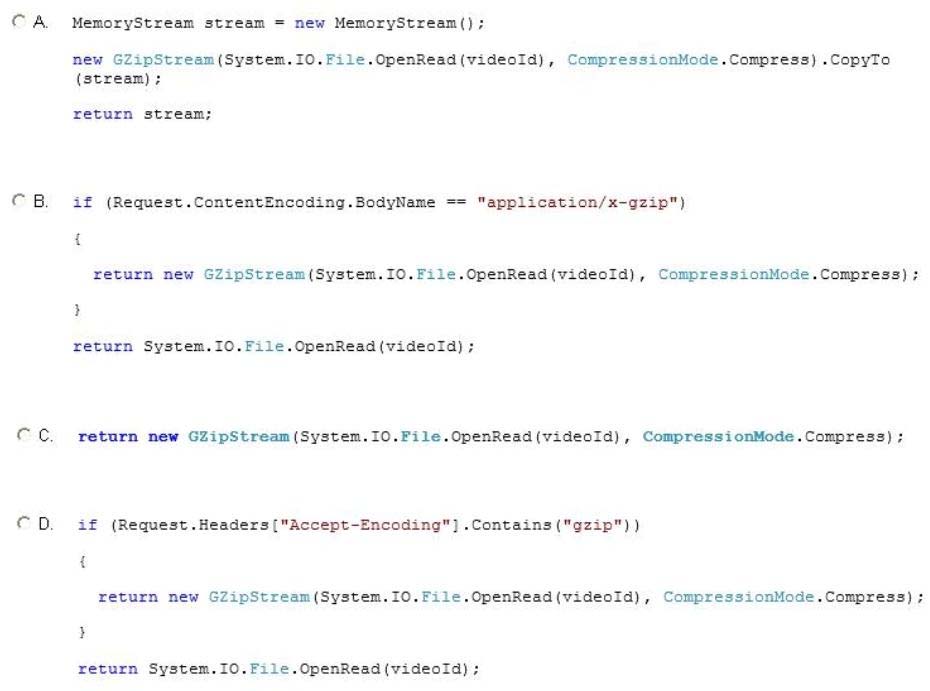
- A. Option A
- B. Option B
- C. Option C
- D. Option D
Answer : D
Explanation:
Question 5
Background -
You are developing a video transcoding service. This service is used by customers to upload video files, convert video to other formats, and view the converted files. This service is used by customers all over the world.
Business Requirements -
The user-facing portion of the application is an ASP.NET MVC application. It provides an interface for administrators to upload video and schedule transcoding. It also enables administrators and users to download the transcoded videos.
When videos are uploaded, they are populated with metadata used to identify the video. The video metadata is gathered by only one system when the video upload is complete.
Customers require support for Microsoft Internet Explorer 7 and later.
The application contains a header that is visible on every page.
If the logged-on user is an administrator, then the header will contain links to administrative functions. This information is read from a cookie that is set on the server. The administrative links must not be present if an error condition is present.
Technical Requirements -
User Experience:
The front-end web application enables a user to view a list of videos.
The main view of the application is the web page that displays the list of videos.
HTML elements other than the list of videos are changed with every request requiring the page to reload.
Compatibility:
Some customers use browsers that do not support the HTTP DELETE verb.
These browsers send a POST request with an HTTP header of X-Delete when the intended action is to delete.
Transcoding:
The video transcoding occurs on a set of Windows Azure worker roles.
The transcoding is performed by a third-party command line tool named transcode.exe. When the tool is installed, an Environment variable named transcode contains the path to the utility.
A variable named license contains the license key. The license for the transcoding utility requires that it be unregistered when it is not in use.
The transcoding utility requires a significant amount of resources. A maximum of 10 instances of the utility can be running at any one time. If an instance of the role cannot process an additional video, it must not prevent any other roles from processing that video.
The utility logs errors to a Logs directory under the utilities path.
A local Azure directory resource named perf is used to capture performance data.
Development:
Developers must use Microsoft Remote Desktop Protocol (RDP) to view errors generated by the transcode.exe utility.
An x509 certificate has been created and distributed to the developers for this purpose.
Developers must be able to use only RDP and not any other administrative functions.
Application Structure -




The transcode.exe utility activates its license online when it is installed.
You need to ensure that the registration of the transcode utility is handled as specified in its license.
Which method should you add to the TranscodeWorkerRole class?
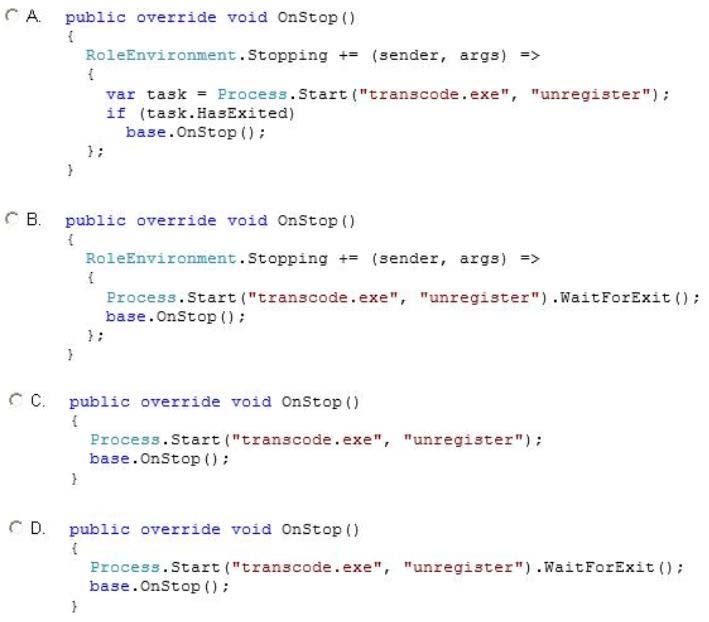
- A. Option A
- B. Option B
- C. Option C
- D. Option D
Answer : D
Explanation:
Question 6
Background -
You are developing a video transcoding service. This service is used by customers to upload video files, convert video to other formats, and view the converted files. This service is used by customers all over the world.
Business Requirements -
The user-facing portion of the application is an ASP.NET MVC application. It provides an interface for administrators to upload video and schedule transcoding. It also enables administrators and users to download the transcoded videos.
When videos are uploaded, they are populated with metadata used to identify the video. The video metadata is gathered by only one system when the video upload is complete.
Customers require support for Microsoft Internet Explorer 7 and later.
The application contains a header that is visible on every page.
If the logged-on user is an administrator, then the header will contain links to administrative functions. This information is read from a cookie that is set on the server. The administrative links must not be present if an error condition is present.
Technical Requirements -
User Experience:
The front-end web application enables a user to view a list of videos.
The main view of the application is the web page that displays the list of videos.
HTML elements other than the list of videos are changed with every request requiring the page to reload.
Compatibility:
Some customers use browsers that do not support the HTTP DELETE verb.
These browsers send a POST request with an HTTP header of X-Delete when the intended action is to delete.
Transcoding:
The video transcoding occurs on a set of Windows Azure worker roles.
The transcoding is performed by a third-party command line tool named transcode.exe. When the tool is installed, an Environment variable named transcode contains the path to the utility.
A variable named license contains the license key. The license for the transcoding utility requires that it be unregistered when it is not in use.
The transcoding utility requires a significant amount of resources. A maximum of 10 instances of the utility can be running at any one time. If an instance of the role cannot process an additional video, it must not prevent any other roles from processing that video.
The utility logs errors to a Logs directory under the utilities path.
A local Azure directory resource named perf is used to capture performance data.
Development:
Developers must use Microsoft Remote Desktop Protocol (RDP) to view errors generated by the transcode.exe utility.
An x509 certificate has been created and distributed to the developers for this purpose.
Developers must be able to use only RDP and not any other administrative functions.
Application Structure -




DRAG DROP -
You need to ensure that the transcode.exe utility is installed before the worker role starts.
How should you implement the startup task? (To answer, drag the appropriate values to the correct element or attribute. Each value may be used once, more than once, or not at all. You may need to drag the split bar between panes or scroll to view content.)
Select and Place:
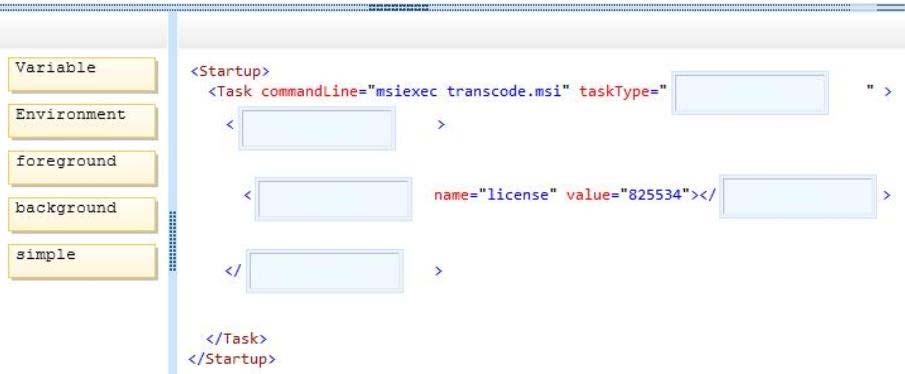
Answer : 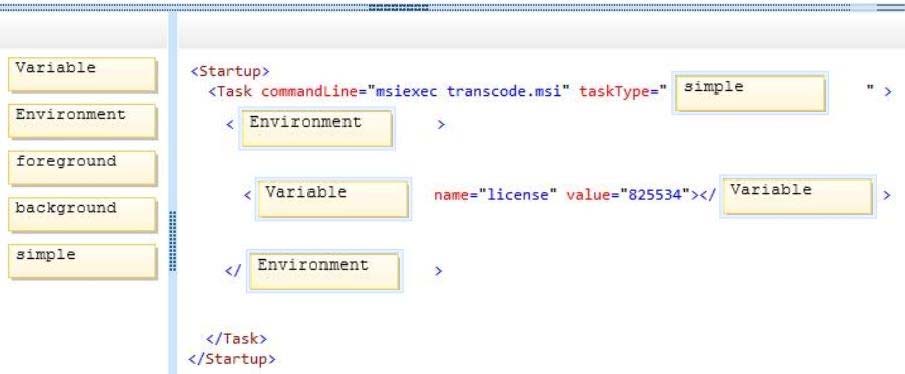
Question 7
Background -
You are developing a video transcoding service. This service is used by customers to upload video files, convert video to other formats, and view the converted files. This service is used by customers all over the world.
Business Requirements -
The user-facing portion of the application is an ASP.NET MVC application. It provides an interface for administrators to upload video and schedule transcoding. It also enables administrators and users to download the transcoded videos.
When videos are uploaded, they are populated with metadata used to identify the video. The video metadata is gathered by only one system when the video upload is complete.
Customers require support for Microsoft Internet Explorer 7 and later.
The application contains a header that is visible on every page.
If the logged-on user is an administrator, then the header will contain links to administrative functions. This information is read from a cookie that is set on the server. The administrative links must not be present if an error condition is present.
Technical Requirements -
User Experience:
The front-end web application enables a user to view a list of videos.
The main view of the application is the web page that displays the list of videos.
HTML elements other than the list of videos are changed with every request requiring the page to reload.
Compatibility:
Some customers use browsers that do not support the HTTP DELETE verb.
These browsers send a POST request with an HTTP header of X-Delete when the intended action is to delete.
Transcoding:
The video transcoding occurs on a set of Windows Azure worker roles.
The transcoding is performed by a third-party command line tool named transcode.exe. When the tool is installed, an Environment variable named transcode contains the path to the utility.
A variable named license contains the license key. The license for the transcoding utility requires that it be unregistered when it is not in use.
The transcoding utility requires a significant amount of resources. A maximum of 10 instances of the utility can be running at any one time. If an instance of the role cannot process an additional video, it must not prevent any other roles from processing that video.
The utility logs errors to a Logs directory under the utilities path.
A local Azure directory resource named perf is used to capture performance data.
Development:
Developers must use Microsoft Remote Desktop Protocol (RDP) to view errors generated by the transcode.exe utility.
An x509 certificate has been created and distributed to the developers for this purpose.
Developers must be able to use only RDP and not any other administrative functions.
Application Structure -




You need to ensure that all customers can delete videos regardless of their browser capability.
Which code segment should you use as the body of the SendAsync method in the DeleteHandler class?
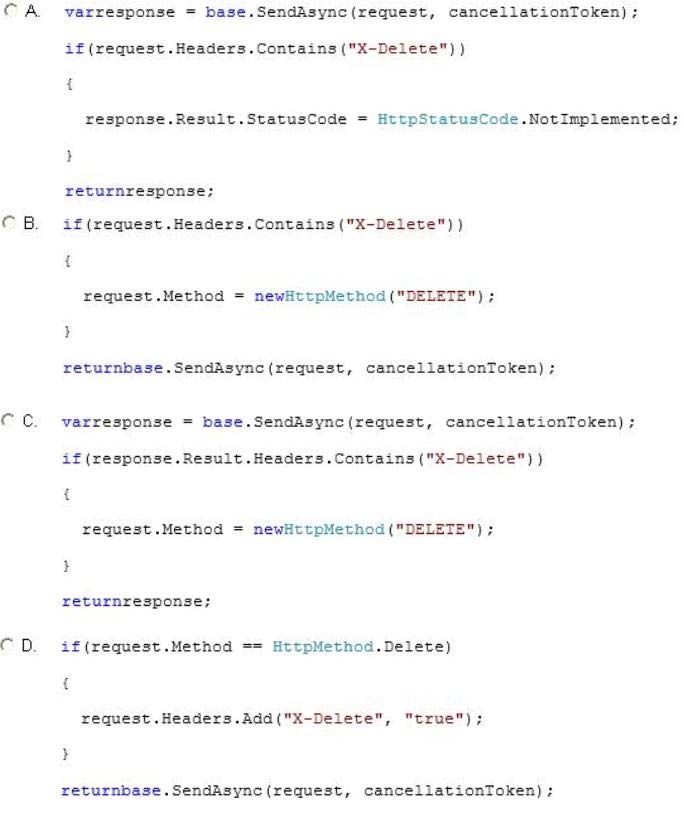
- A. Option A
- B. Option B
- C. Option C
- D. Option D
Answer : B
Explanation:
Question 8
Background -
You are developing a video transcoding service. This service is used by customers to upload video files, convert video to other formats, and view the converted files. This service is used by customers all over the world.
Business Requirements -
The user-facing portion of the application is an ASP.NET MVC application. It provides an interface for administrators to upload video and schedule transcoding. It also enables administrators and users to download the transcoded videos.
When videos are uploaded, they are populated with metadata used to identify the video. The video metadata is gathered by only one system when the video upload is complete.
Customers require support for Microsoft Internet Explorer 7 and later.
The application contains a header that is visible on every page.
If the logged-on user is an administrator, then the header will contain links to administrative functions. This information is read from a cookie that is set on the server. The administrative links must not be present if an error condition is present.
Technical Requirements -
User Experience:
The front-end web application enables a user to view a list of videos.
The main view of the application is the web page that displays the list of videos.
HTML elements other than the list of videos are changed with every request requiring the page to reload.
Compatibility:
Some customers use browsers that do not support the HTTP DELETE verb.
These browsers send a POST request with an HTTP header of X-Delete when the intended action is to delete.
Transcoding:
The video transcoding occurs on a set of Windows Azure worker roles.
The transcoding is performed by a third-party command line tool named transcode.exe. When the tool is installed, an Environment variable named transcode contains the path to the utility.
A variable named license contains the license key. The license for the transcoding utility requires that it be unregistered when it is not in use.
The transcoding utility requires a significant amount of resources. A maximum of 10 instances of the utility can be running at any one time. If an instance of the role cannot process an additional video, it must not prevent any other roles from processing that video.
The utility logs errors to a Logs directory under the utilities path.
A local Azure directory resource named perf is used to capture performance data.
Development:
Developers must use Microsoft Remote Desktop Protocol (RDP) to view errors generated by the transcode.exe utility.
An x509 certificate has been created and distributed to the developers for this purpose.
Developers must be able to use only RDP and not any other administrative functions.
Application Structure -




You need to ensure that all the MVC controllers are secure.
Which code segment should you use as the body for the CreateController method in AdminVerifierFactory.cs?
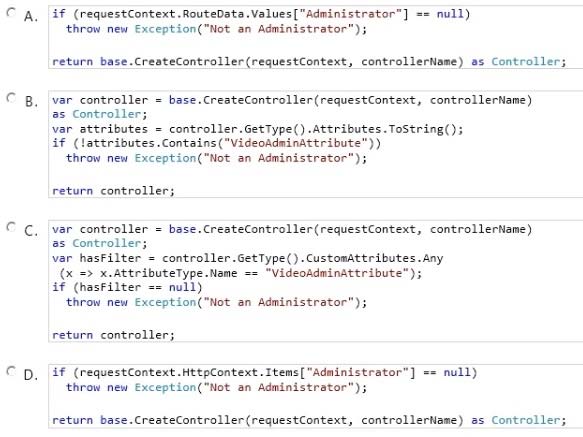
- A. Option A
- B. Option B
- C. Option C
- D. Option D
Answer : C
Explanation:
The MemberInfo.CustomAttributes property gets a collection that contains this member's custom attributes.
The Any() statement will either return null or a collection of matched custom attributes. If itmatches one or more, the controller is secure, otherwise an exception is thrown.
From scenario: The application contains a header that is visible on every page.
If the logged-on user is an administrator, then the header will contain links to administrative functions. This information is read from a cookie that is set on the server. The administrative links must not be present if an error condition is present.
Incorrect:
Not B: controller.GetType().Attributes will not return custom attributes.
References:
https://msdn.microsoft.com/en-us/library/system.reflection.memberinfo.customattributes(v=vs.110).aspx
Question 9
Background -
You are developing a video transcoding service. This service is used by customers to upload video files, convert video to other formats, and view the converted files. This service is used by customers all over the world.
Business Requirements -
The user-facing portion of the application is an ASP.NET MVC application. It provides an interface for administrators to upload video and schedule transcoding. It also enables administrators and users to download the transcoded videos.
When videos are uploaded, they are populated with metadata used to identify the video. The video metadata is gathered by only one system when the video upload is complete.
Customers require support for Microsoft Internet Explorer 7 and later.
The application contains a header that is visible on every page.
If the logged-on user is an administrator, then the header will contain links to administrative functions. This information is read from a cookie that is set on the server. The administrative links must not be present if an error condition is present.
Technical Requirements -
User Experience:
The front-end web application enables a user to view a list of videos.
The main view of the application is the web page that displays the list of videos.
HTML elements other than the list of videos are changed with every request requiring the page to reload.
Compatibility:
Some customers use browsers that do not support the HTTP DELETE verb.
These browsers send a POST request with an HTTP header of X-Delete when the intended action is to delete.
Transcoding:
The video transcoding occurs on a set of Windows Azure worker roles.
The transcoding is performed by a third-party command line tool named transcode.exe. When the tool is installed, an Environment variable named transcode contains the path to the utility.
A variable named license contains the license key. The license for the transcoding utility requires that it be unregistered when it is not in use.
The transcoding utility requires a significant amount of resources. A maximum of 10 instances of the utility can be running at any one time. If an instance of the role cannot process an additional video, it must not prevent any other roles from processing that video.
The utility logs errors to a Logs directory under the utilities path.
A local Azure directory resource named perf is used to capture performance data.
Development:
Developers must use Microsoft Remote Desktop Protocol (RDP) to view errors generated by the transcode.exe utility.
An x509 certificate has been created and distributed to the developers for this purpose.
Developers must be able to use only RDP and not any other administrative functions.
Application Structure -




You need to ensure that developers can connect to a Windows Azure role by using RDP.
What should you do?
- A. Export a certificate without a private key. Upload the .cer file to the Management Certificates section on the Azure Management Portal.
- B. Export a certificate with a private key. Upload the .pfxfile to the Management Certificates section on the Azure Management Portal.
- C. Export a certificate without a private key. Upload the .cer file to the Certificates section under the TranscodeWorkerRole hosted service on the Azure Management Portal.
- D. Export a certificate with a private key. Upload the .pfx file to the Certificates section under the TranscodeWorkerRole hosted service on the Azure Management Portal.
Answer : D
Explanation:
In case you don"™t want to use the RDP certificate created by WindowsAzure Tools and want to use a custom certificate instead, the following steps will guide you.
These steps can also be used in case package is not being published from Visual Studio rather it is being built locally, saved in either Local Machine's Drive or
Windows Azure Blob Storage and subsequently published from there.
Here are the steps which are required to get pass the publishing error which you might be running into. You would need to upload the Certificate with Private Key to the portal (when VisualStudio is used this is done in the background).
Detailed steps.
-> In Visual Studio, go to the solution which is being developed.
-> Right click the Web Project -> Configure Remote Desktop -> click on View to see Certificate details (Since I don"™t have a custom certificate I will use one create by Windows Azure Tools itself)
-> Go to Details tab on Certificate -> Click Copy to file. -> Next -> Select "˜Yes, export the private key"™ -> Next -> Continue with default setting and create a password when asked (please refer below screenshots)
-> These steps will generate a .PFX file for this certificate. Now we need to upload this certificate to the portal (for the respective cloud service)
-> Go to the Azure Management Portal -> Go to the Cloud Service in question ->Certificates Tab -> Upload the newly created certificate (.PFX file)
Note:
The certificates that you need for a remote desktop connection are different from the certificates that you use for other Azure operations. The remote access certificate must have a private key.
Microsoft Azure uses certificates in three ways:
-> Management certificates "" Stored at the subscription level, these certificates are used to enable the use of the SDK tools, the Windows Azure Tools for
Microsoft Visual Studio, or the Service Management REST API Reference. These certificates are independent of any cloud service or deployment.
-> Service certificates "" Stored at the cloud service level, these certificates are used by your deployed services.
-> SSH Keys "" Stored on the Linux virtual machine, SSH keys are used to authenticate remote connections to the virtual machine.
Reference: How to use Custom Certificate for RDP to Windows Azure Roles http://blogs.msdn.com/b/cie/archive/2014/02/22/how-to-use-custom-certificate-for-rdp-to-windows-azure-roles.aspx
Question 10
Background -
You are developing a video transcoding service. This service is used by customers to upload video files, convert video to other formats, and view the converted files. This service is used by customers all over the world.
Business Requirements -
The user-facing portion of the application is an ASP.NET MVC application. It provides an interface for administrators to upload video and schedule transcoding. It also enables administrators and users to download the transcoded videos.
When videos are uploaded, they are populated with metadata used to identify the video. The video metadata is gathered by only one system when the video upload is complete.
Customers require support for Microsoft Internet Explorer 7 and later.
The application contains a header that is visible on every page.
If the logged-on user is an administrator, then the header will contain links to administrative functions. This information is read from a cookie that is set on the server. The administrative links must not be present if an error condition is present.
Technical Requirements -
User Experience:
The front-end web application enables a user to view a list of videos.
The main view of the application is the web page that displays the list of videos.
HTML elements other than the list of videos are changed with every request requiring the page to reload.
Compatibility:
Some customers use browsers that do not support the HTTP DELETE verb.
These browsers send a POST request with an HTTP header of X-Delete when the intended action is to delete.
Transcoding:
The video transcoding occurs on a set of Windows Azure worker roles.
The transcoding is performed by a third-party command line tool named transcode.exe. When the tool is installed, an Environment variable named transcode contains the path to the utility.
A variable named license contains the license key. The license for the transcoding utility requires that it be unregistered when it is not in use.
The transcoding utility requires a significant amount of resources. A maximum of 10 instances of the utility can be running at any one time. If an instance of the role cannot process an additional video, it must not prevent any other roles from processing that video.
The utility logs errors to a Logs directory under the utilities path.
A local Azure directory resource named perf is used to capture performance data.
Development:
Developers must use Microsoft Remote Desktop Protocol (RDP) to view errors generated by the transcode.exe utility.
An x509 certificate has been created and distributed to the developers for this purpose.
Developers must be able to use only RDP and not any other administrative functions.
Application Structure -




Customers download videos by using HTTP clients that support various content encodings.
You need to configure caching on the DownloadVideo action to maximize performance.
Which attribute should you add?
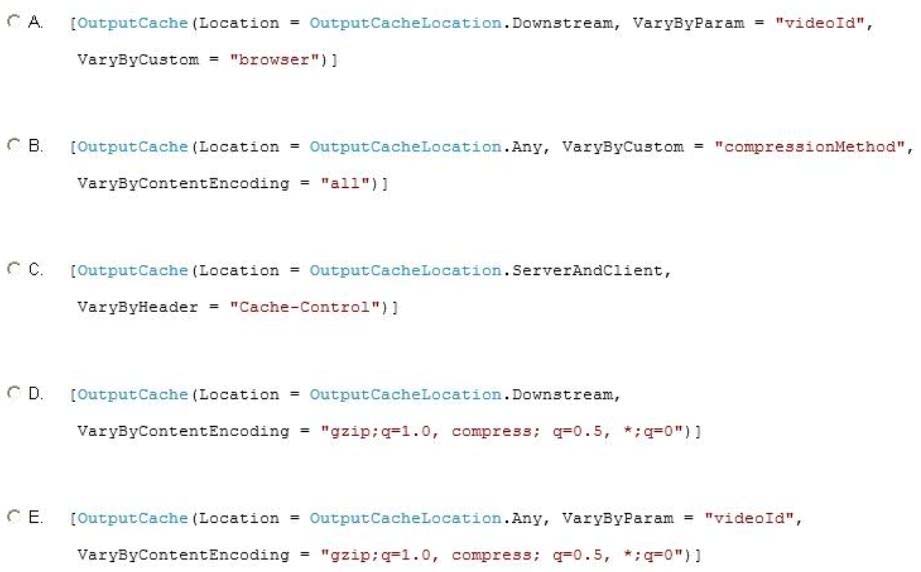
- A. Option A
- B. Option B
- C. Option C
- D. Option D
- E. Option E
Answer : E
Explanation:
References:
https://msdn.microsoft.com/en-us/library/system.web.mvc.outputcacheattribute_properties(v=vs.118).aspx
Question 11
You are designing an HTML5 website.
You need to design the interface to make the content of the web page viewable in all types of browsers, including voice recognition software, screen readers, and reading pens.
What are two possible ways to achieve the goal? Each correct answer presents a complete solution.
- A. Annotate HTML5 content elements with Accessible Rich Internet Application (ARIA) attributes.
- B. Convert HTML5 forms to XForms.
- C. Ensure that HTML5 content elements have valid and descriptive names
- D. Use HTML5 semantic markup elements to enhance the pages.
- E. Use Resource Description Framework (RDF) to describe content elements throughout the entire page.
Answer : AD
Explanation:
A: The aria-describedby property may be used to attach descriptive information to one or more elements through the use of an id reference list. The id reference list contains one or more unique element ids.
D: A semantic element clearly describes its meaning to both the browser and the developer.
References:
https://www.w3.org/TR/WCAG20-TECHS/ARIA1.html
https://www.w3schools.com/html/html5_semantic_elements.asp
Question 12
DRAG DROP -
You are developing an ASP.NET MVC web application in Visual Studio.
The application has a model named ReservationLocation that contains properties named City and State.
The view that displays reservations has a single text box named loc for entering the location information. The location is entered as city, state.
There are action methods that have ReservationLocation as a parameter type.
You need to ensure that the City and State properties are correctly populated.
How should you implement model binding for the ReservationLocation type? (To answer, drag the appropriate code segment to the correct location or locations.
Each code segment may be used once, more than once, or not at all. You may need to drag the split bar between panes or scroll to view content.)
Select and Place:
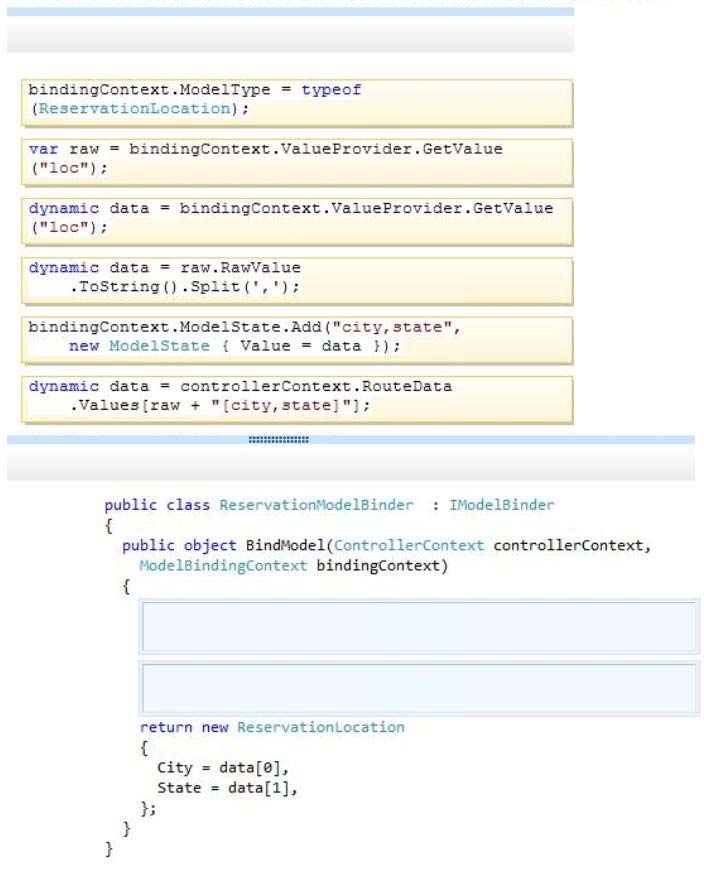
Answer : 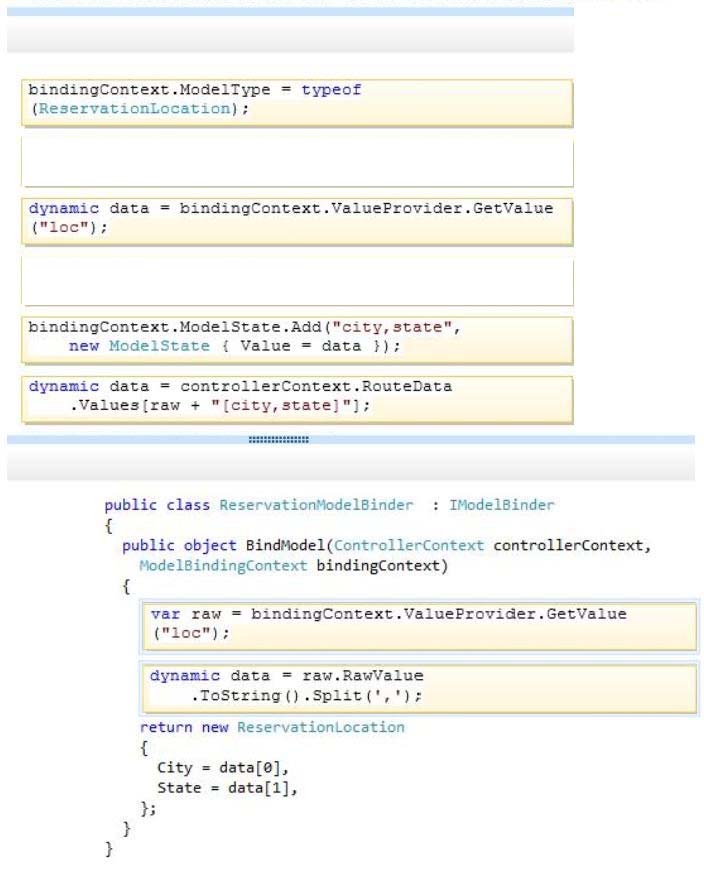
Question 13
You are developing an ASP.NET MVC web application in Visual Studio. The application requires several thousand content files. All content is hosted on the same
IIS instance as the application.
You detect performance issues when the application starts.
You need to resolve the performance issues.
What should you do?
- A. Implement HTTP caching in the ASP.NET MVC controllers.
- B. Combine the content files by using ASP.NET MVC bundling.
- C. Install a second IIS instance.
- D. Move the content to a Windows Azure CDN.
Answer : B
Explanation:
Bundling is a new feature in ASP.NET 4.5 that makes it easy to combine or bundle multiple files into a single file. You can create CSS, JavaScript and other bundles. Fewer files means fewer HTTP requests and that can improve first page load performance.
References:
https://www.asp.net/mvc/overview/performance/bundling-and-minification
Question 14
You are developing an ASP.NET MVC application in Visual Studio. The application supports multiple cultures.
The application contains three resource files in the Resources directory:
-> MyDictionary.resx
-> MyDictionary.es.resx
MyDictionary.fr.resx -

Each file contains a public resource named Title with localized translation.
The application is configured to set the culture based on the client browser settings.
The application contains a controller with the action defined in the following code segment. (Line numbers are included for reference only.)

You need to set ViewBag.Title to the localized title contained in the resource files.
Which code segment should you add to the action at line 03?
- A. ViewBag.Title = HttpContext.GetGlobalResourceObject("MyDictionary", "Title");
- B. ViewBag.Title = HttpContext.GetGlobalResourceObject("MyDictionary", "Title", new System.Globalization.CultureInfo("en"));
- C. ViewBag.Title = Resources.MyDictionary.Title;
- D. ViewBag.Title = HttpContext.GetLocalResourceObject("MyDictionary", "Title");
Answer : C
Explanation:
Only the Resources class is used.
Question 15
You are testing an ASP.NET application.
The test plan requires that tests run against the application's business layer.
You need to use the test project template that meets this requirement.
Which template should you use?
- A. Web Test Project
- B. Load Test Project
- C. Unit Test Project
- D. Coded Test Project
Answer : C
Explanation: